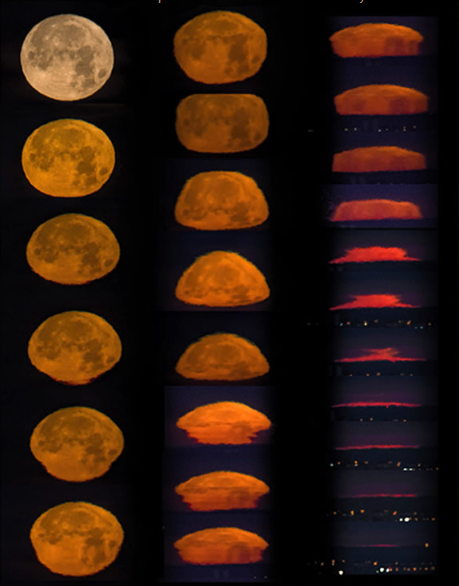Miraged Moonset - OPOD
Miraged Moonset: A Stunning Atmospheric Phenomenon
Have you ever witnessed a miraged moonset? This captivating atmospheric optics phenomenon occurs when an almost full moon descends over the desert landscape, creating a mesmerizing display of distorted images. In this blog post, we will delve into the intricacies of miraged moonsets, exploring the science behind them and unraveling the stunning sequence captured by photographer James Newt Perdue.
The Dance of Temperature Inversions
As the night unfolds, the desert's surface radiates heat away into space, causing the surroundings to cool down. This cooling effect extends to the lower layers of the atmosphere, giving rise to temperature inversions. These inversions occur when a layer of cold air settles beneath a layer of warmer air, creating a stark contrast in temperature gradients. It is within these inversions that mirages find their playground.
The Sequence Unveiled
Perdue's photographic sequence provides a fascinating glimpse into the progression of a miraged moonset. Let's break down the key moments captured in his series:
-
Flattened Moon: The sequence begins with the moon already appearing noticeably flattened. This distortion is an early indication of the temperature inversions at play.
-
The South Bulge: As the moon continues to descend, it encounters a strong inversion. The southern portion of the moon bulges downwards due to refraction across the temperature gradients within the inversion layer.
-
The Second Bulge: Another inversion manifests itself as a bulge beneath the initial bulge. This double bulge effect adds depth and complexity to the miraged moonset.
-
A Mock Mirage: The final segment of the sequence showcases a classical mock mirage, where three distinct images of the moon are visible. The uppermost image descends, the next is inverted and ascends, and the image closest to the horizon remains erect but sinks.
Atmospheric Absorption and Color Transformations
As the moon nears the horizon, atmospheric absorption becomes more pronounced, particularly within the inversion layers. This absorption affects the colors observed in the miraged moonset. Perdue's unaltered images accurately depict the transformation of the moon's appearance as it descends. The silvery moon gradually transitions to shades of orange and eventually to captivating red hues as the atmosphere scatters shorter wavelengths.
Unveiling the Beauty of Atmospheric Optics
The miraged moonset captured by James Newt Perdue serves as a testament to the mesmerizing beauty of atmospheric optics. By observing and documenting these natural phenomena, we gain a deeper understanding of the intricate workings of our atmosphere. Miraged moonsets remind us of the ever-changing nature of our world and the captivating surprises that await us when we take the time to look up at the sky.
So, next time you find yourself gazing at the moon as it sets over a desert landscape, keep an eye out for the subtle distortions and enchanting mirages that may unfold before your eyes. You never know what captivating display of atmospheric optics you might witness.

Miraged Moonset
An almost full moon sets over the Arizona/California desert. A morning sequence taken over 8 minutes by James Newt Perdue.
Overnight the desert has radiated heat away into space. The chilled surface has in turn cooled the lower air layers to create several temperature inversions. Cold air beneath warmer - The stuff of mirages.
The sequence starts with the moon already noticeably flattened. Then the moon sinks into a strong inversion. Its south bulges downwards as refraction across the inversion temperature gradients takes hold.
Then a second inversion shows as a bulge beneath the bulge.
The final sequence is a classical mock mirage with three images. The uppermost descends. The next is inverted and ascends. That nearest the horizon is erect and sinking.
Atmospheric absorption increases towards the horizon and within the inversion layers. The image colours are not manipulated and are realistic. The silvery moon turns to orange and then to reds as the atmosphere scatters more and more short wavelengths elsewhere.
All images ©James Newt Perdue, shown with permission

Note: this article has been automatically converted from the old site and may not appear as intended. You can find the original article here.
Reference Atmospheric Optics
If you use any of the definitions, information, or data presented on Atmospheric Optics, please copy the link or reference below to properly credit us as the reference source. Thank you!
-
<a href="https://atoptics.co.uk/blog/miraged-moonset-opod/">Miraged Moonset - OPOD</a>
-
"Miraged Moonset - OPOD". Atmospheric Optics. Accessed on November 26, 2024. https://atoptics.co.uk/blog/miraged-moonset-opod/.
-
"Miraged Moonset - OPOD". Atmospheric Optics, https://atoptics.co.uk/blog/miraged-moonset-opod/. Accessed 26 November, 2024
-
Miraged Moonset - OPOD. Atmospheric Optics. Retrieved from https://atoptics.co.uk/blog/miraged-moonset-opod/.